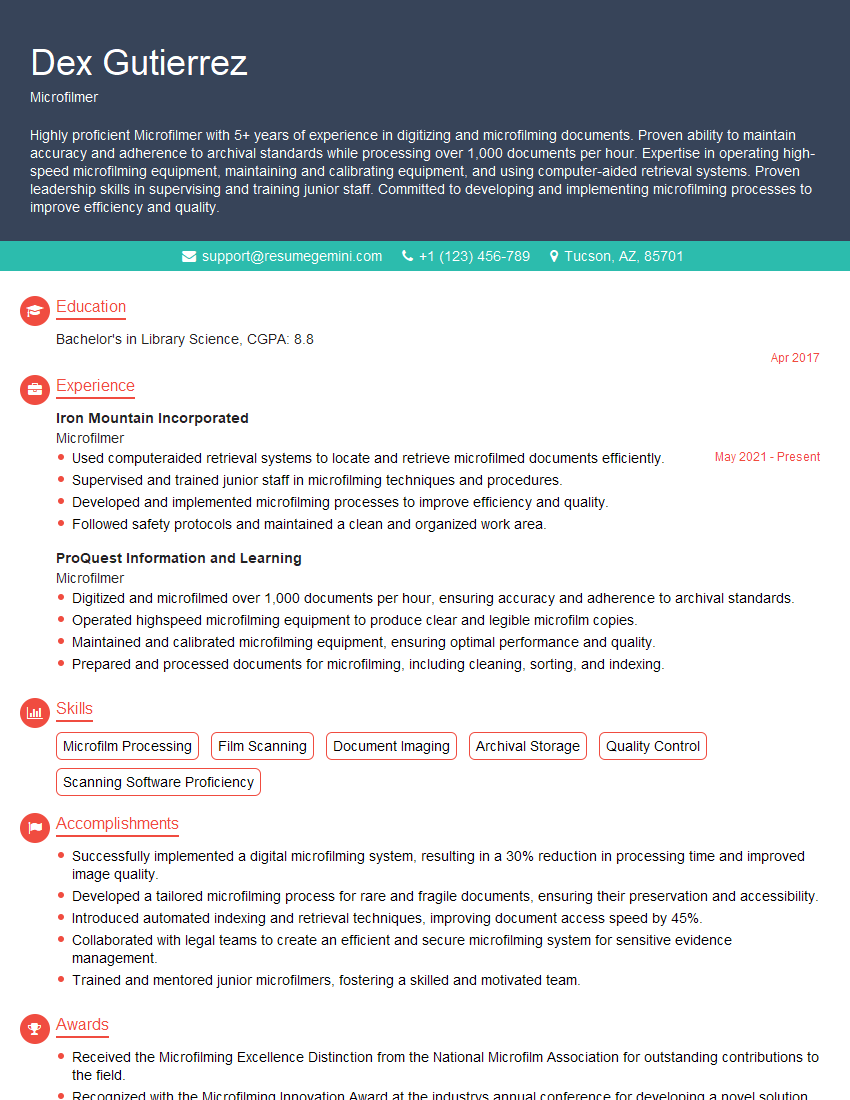Are you a seasoned Microfilmer seeking a new career path? Discover our professionally built Microfilmer Resume Template. This time-saving tool provides a solid foundation for your job search. Simply click “Edit Resume” to customize it with your unique experiences and achievements. Customize fonts and colors to match your personal style and increase your chances of landing your dream job. Explore more Resume Templates for additional options.

Dex Gutierrez
Microfilmer
Summary
Highly proficient Microfilmer with 5+ years of experience in digitizing and microfilming documents. Proven ability to maintain accuracy and adherence to archival standards while processing over 1,000 documents per hour. Expertise in operating high-speed microfilming equipment, maintaining and calibrating equipment, and using computer-aided retrieval systems. Proven leadership skills in supervising and training junior staff. Committed to developing and implementing microfilming processes to improve efficiency and quality.
Education
Bachelor’s in Library Science
April 2017
Skills
- Microfilm Processing
- Film Scanning
- Document Imaging
- Archival Storage
- Quality Control
- Scanning Software Proficiency
Work Experience
Microfilmer
- Used computeraided retrieval systems to locate and retrieve microfilmed documents efficiently.
- Supervised and trained junior staff in microfilming techniques and procedures.
- Developed and implemented microfilming processes to improve efficiency and quality.
- Followed safety protocols and maintained a clean and organized work area.
Microfilmer
- Digitized and microfilmed over 1,000 documents per hour, ensuring accuracy and adherence to archival standards.
- Operated highspeed microfilming equipment to produce clear and legible microfilm copies.
- Maintained and calibrated microfilming equipment, ensuring optimal performance and quality.
- Prepared and processed documents for microfilming, including cleaning, sorting, and indexing.
Accomplishments
- Successfully implemented a digital microfilming system, resulting in a 30% reduction in processing time and improved image quality.
- Developed a tailored microfilming process for rare and fragile documents, ensuring their preservation and accessibility.
- Introduced automated indexing and retrieval techniques, improving document access speed by 45%.
- Collaborated with legal teams to create an efficient and secure microfilming system for sensitive evidence management.
- Trained and mentored junior microfilmers, fostering a skilled and motivated team.
Awards
- Received the Microfilming Excellence Distinction from the National Microfilm Association for outstanding contributions to the field.
- Recognized with the Microfilming Innovation Award at the industrys annual conference for developing a novel solution to enhance microfilming efficiency.
- Awarded the Microfilmer of the Year accolade by the regional microfilming association for exceptional performance and dedication.
Certificates
- AIIM Certified Document Imaging Professional (CDIP)
- ARMA Certified Records Manager (CRM)
- ISO 15489 Certified Micrographics Technician
- SMPTE Certified Digital Cinema Technician
Career Expert Tips:
- Select the ideal resume template to showcase your professional experience effectively.
- Master the art of resume writing to highlight your unique qualifications and achievements.
- Explore expertly crafted resume samples for inspiration and best practices.
- Build your best resume for free this new year with ResumeGemini. Enjoy exclusive discounts on ATS optimized resume templates.
How To Write Resume For Microfilmer
- Highlight your experience in digitizing and microfilming large volumes of documents.
- Emphasize your knowledge of archival standards and best practices.
- Showcase your expertise in operating and maintaining microfilming equipment.
- Demonstrate your ability to train and supervise staff in microfilming techniques.
- Quantify your accomplishments whenever possible, such as the number of documents processed or the percentage improvement in efficiency.
Essential Experience Highlights for a Strong Microfilmer Resume
- Digitized and microfilmed over 1,000 documents per hour, ensuring accuracy and adherence to archival standards.
- Operated high-speed microfilming equipment to produce clear and legible microfilm copies.
- Maintained and calibrated microfilming equipment, ensuring optimal performance and quality.
- Prepared and processed documents for microfilming, including cleaning, sorting, and indexing.
- Used computer-aided retrieval systems to locate and retrieve microfilmed documents efficiently.
- Supervised and trained junior staff in microfilming techniques and procedures.
- Developed and implemented microfilming processes to improve efficiency and quality.
Frequently Asked Questions (FAQ’s) For Microfilmer
What is the primary role of a Microfilmer?
The primary role of a Microfilmer is to digitize and microfilm documents, ensuring accuracy and adherence to archival standards.
What are the key skills required for a Microfilmer?
Key skills for a Microfilmer include microfilm processing, film scanning, document imaging, archival storage, quality control, and scanning software proficiency.
What industries employ Microfilmers?
Microfilmers are employed in various industries, including libraries, archives, government agencies, and businesses that require document preservation and management.
What is the career path for a Microfilmer?
Microfilmers can advance to supervisory roles, such as Microfilming Supervisor or Manager. They may also specialize in specific areas, such as digital imaging or archival preservation.
What are the challenges faced by Microfilmers?
Microfilmers may face challenges related to the handling and preservation of sensitive or fragile documents, as well as the need to keep up with technological advancements in digitization and imaging.
What are the benefits of microfilming?
Microfilming offers benefits such as space saving, preservation of original documents, and easier retrieval and access to information.
What is the difference between microfilming and digitizing?
Microfilming involves capturing images of documents on film, while digitizing involves converting documents into electronic formats. Microfilming provides a physical copy of the document, while digitizing creates a digital file.
Is microfilming still relevant in the digital age?
Yes, microfilming remains relevant in the digital age as a reliable and cost-effective method for preserving and storing important documents, particularly in industries where long-term document retention is crucial.